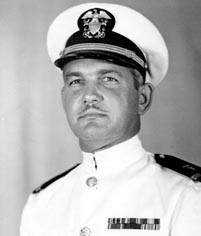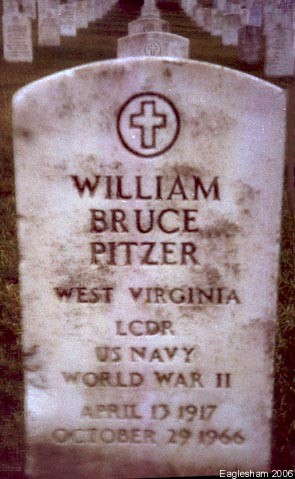
William Bruce Pitzer joined the United States Navy in 1934 and was discharged in 1939, having received training in X-ray technology. He worked as a hospital X-ray technician until 1942 when he re-enlisted, remaining in the Naval Medical Service Corps until his death at age 49, having served in World War II and the Korean conflict. He was assistant head of the Medical Graphic Arts Department and chief of the Television Division at that Naval Medical School, Bethesda, Maryland, and achieved the rank of Lieutenant Commander.
Lieutenant Commander Pitzer was described by a colleague as the “perfect image of a naval officer.” Another stated: “His greatest accomplishments were to come up through the ranks and be an inspiration to other enlisted men and women.”
On November 22, 1963, the autopsy on the body of John F. Kennedy was led by Dr. James J. Humes. A few days after the assassination, a colleague, Dennis D. David, claims to have found Pitzer working on a 16-mm film, slides and black and white photos of the Kennedy autopsy. David noted that those materials showed what appeared to be a small entry wound in the right frontal area with a corresponding large exit wound in the lower rear of the head, inconsistent with shots fired from behind as stated in the Warren Commission’s report.
According to Humes and others, Pitzer was not present at the autopsy. However, Humes stated that the Bethesda Naval Hospital was equipped with closed-circuit television; the use of CCTV as an instructional tool was a particular interest of Commander Pitzer.
On October 29, 1966, William Pitzer was found dead in the television studio at the Naval Medical School. Investigations by the Naval Investigative Service and the Federal Bureau of Investigation concluded that a gunshot wound to the right temple had been self-inflicted. However, rumor that Pitzer had been left-handed led to speculation that the death was a homicide.
FBI files on the investigation, released in 1997 under the Freedom of Information Act (FOIA), seemed to support the theory that Pitzer been murdered. Tests of his right hand indicated no exposure to gunshot residue. There was no “tattooing” of the skin around the entry wound; such burn-specks are usually found when a firearm is discharged in close proximity, and tests indicated that the revolver would have been held at a distance of more than 3 ft to preclude tattooing. Although Pitzer had requisitioned the navy-issued revolver found near the body, the FBI could find no record of his acquiring live ammunition. The autopsy showed both entry and exit wounds to the head and a third defect in the skull bone. Furthermore, Pitzer, an inveterate note-maker, did not leave a suicide note although a writing pad was on a chair near the body.
In 2002, a member of the family, under FOIA, obtained copies of photographs taken at the autopsy on William Pitzer’s body. They show what appears to be a tight-contact shot in the right temple, and an exit wound above and slightly posterior to the left ear. No lesion is visible in the left temple. Soot deposits on the right and left hands provide evidence of how the revolver was held so as to preclude “tattooing” around the entry wound. The third defect in the skull is explainable in terms of a tight-contact shot causing momentary pressurization of the cranium. Examination of the methodology used to test for exposure of the right hand to gunshot residue reveals that the assay was not done properly; other evidence suggests that, in fact, the right hand was close to the entry wound at discharge. Furthermore, family members have stated unequivocally that he was right-handed.
Although the autopsy photographs indicate suicide, speculation on how William Pitzer died is likely to continue until the photographs are made available for examination by forensic experts.
JOYCE BRUCE PITZER (Age 92)
Widow of Lieutenant Commander William Bruce Pitzer, late of Takoma Park, Maryland, died May 7, 2007 in Connecticut from pneumonia. She is survived by her two sons, William, II of Orick, California and Robert of North Hollywood, California; sisters-in-law Jeanne Bruce of Medford, New Jersey, and Elizabeth Rhodes of Laurel, Maryand; two grandsons Christopher and Stephan Pitzer of Eureka, California; great-grandchildren and great-great-grandchildren, as well as many loving nieces and nephews.
A memorial service will be held at the Ft. Myer (Old Post) Chapel at Arlington National Cemetery at 3 p.m. (2:30 p.m. arrival, please) Wednesday, May 30, burial immediately following. Donations in lieu of flowers may be sent to Department of Pastoral Care, Washington Adventist Hospital, 7600 Carroll Avenue, Takoma Park, Maryland 20912.
PITZER, WILLIAM B
- LT. CDR. USN
- DATE OF BIRTH: 04/13/1917
- DATE OF DEATH: 10/29/1966
- BURIED AT: SECTION 37 SITE 284
ARLINGTON NATIONAL CEMETERY
This shocking account of intrigue, lies, and governmental complicity provides dramatic evidence that suggests a larger conspiracy behind JFK’s assassination. Three years after Kennedy’s assassination, Lieutenant William Bruce Pitzer, who was reputed to have in his possession documents and film that refuted the conclusions of JFK’s official autopsy, was found dead in his office at the National Naval Medical Center in Bethesda, Maryland. In 1995, a retired special forces captain claimed that a representative of the CIA recruited him to assassinate Pitzer. This, as well as the mysterious circumstances of Pitzer’s death and the official and nonofficial investigations that followed, are outlined. These revelations of a possible conspiracy within a conspiracy raise larger questions of the measures taken to suppress the truth and the potential dangers of a government that operates outside the law. (Book Review)
Michael Robert Patterson was born in Arlington and is the son of a former officer of the US Army. So it was no wonder that sooner or later his interests drew him to American history and especially to American military history. Many of his articles can be found on renowned portals like the New York Times, Washingtonpost or Wikipedia.
Reviewed by: Michael Howard


